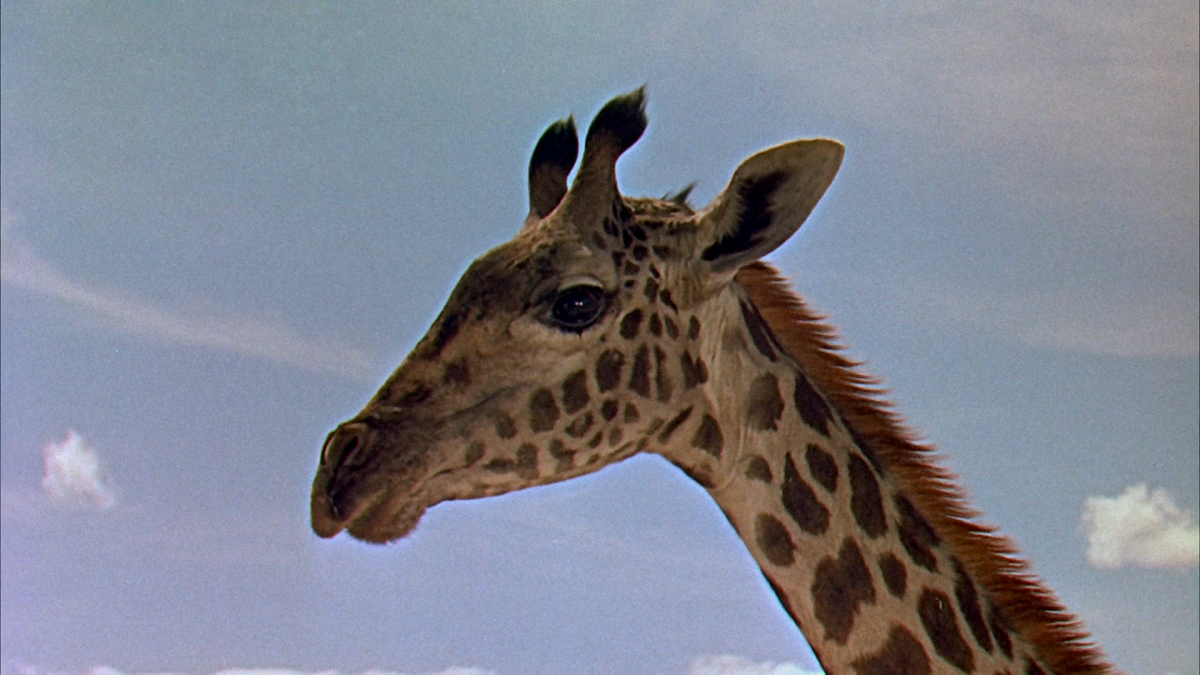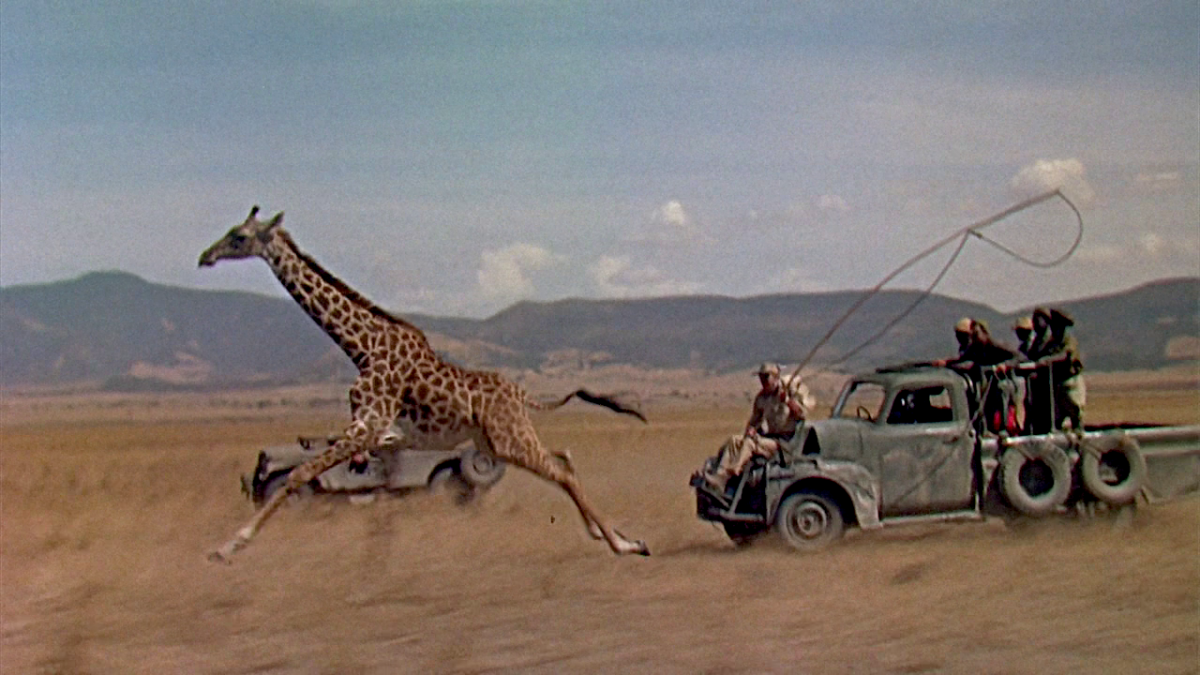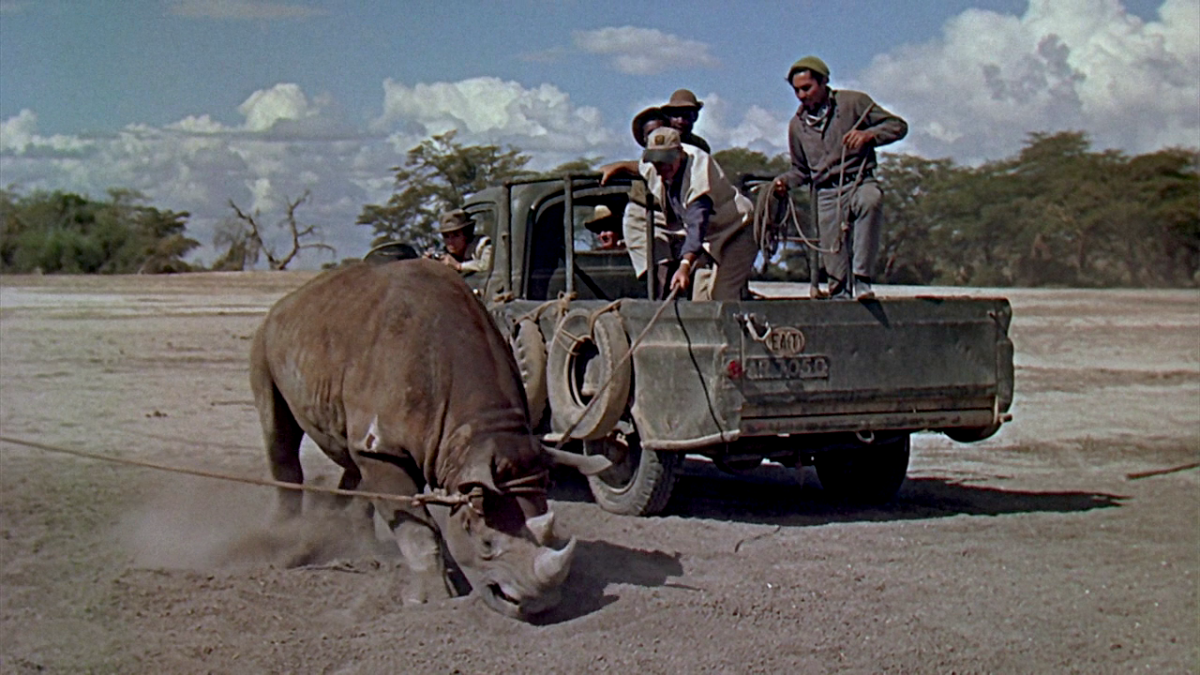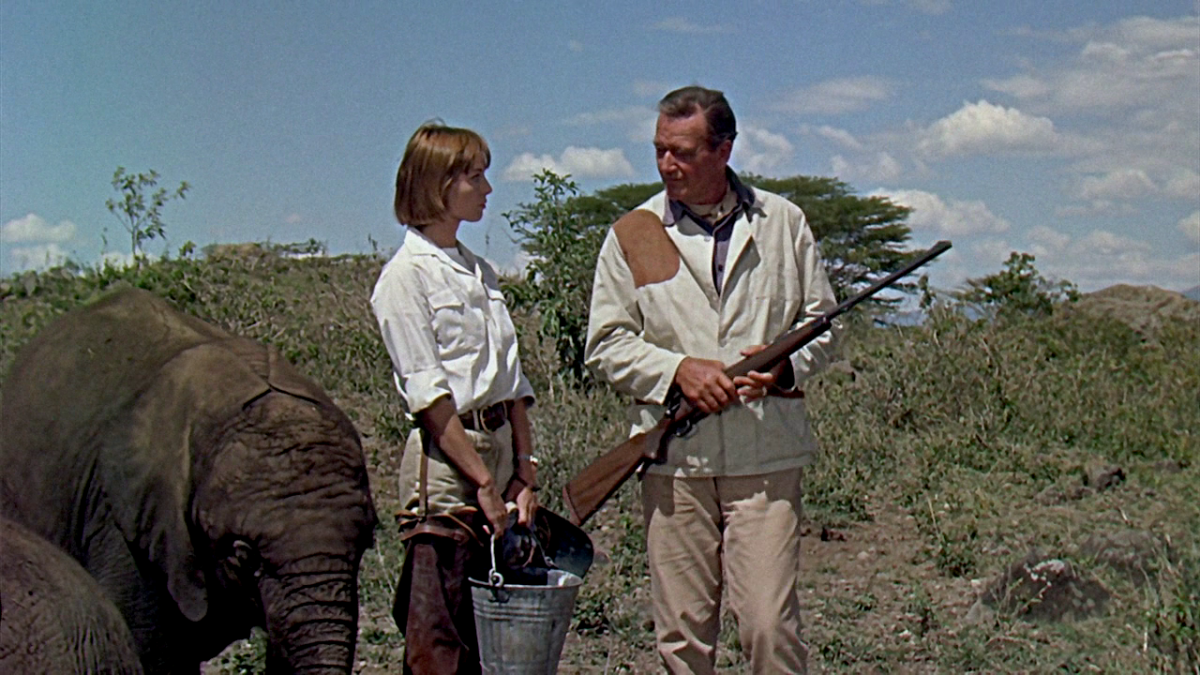Hatari!

Hatari! is an enormous film, one which is only saved from its monstrosity by the incredible intelligence of its director. It is a summation in which all the aspects of cinema are stirred together, amalgamated. The labyrinthine complexity of its construction is dizzying. Watching it can only put one off, or leave them wiped out.
Nevertheless, there is one facet of the film that, despite everything, escapes the bewilderment of those first viewings: the perfection of its documentary portions. In an area where it is generally custom to sacrifice form for substance or vice versa, in accordance with the practicalities of time and location, Hawks’s tone retains an exemplary unity.
This approach is all the more commendable as the challenges caused by the filming of these scenes are tackled head-on, however large. For these sequences, Hawks chose to consider the beasts as full-fledged actors: their physical strength and reflexes influence the behavior of their antagonists just as much as the reactions of one character influences another in a dramatic scene, or more as they intervene on a purely spatial level. Theoretically, this is the simplest solution, as it does not require any sleight of hand to convince the viewer that they have seen things that they’ve not been shown. But it is also the most perilous because, by choosing this approach, Hawks put himself at the mercy of uncontrollable elements, whose reactions he and those he directed had to instantly adapt to; moreover, the slightest error on his part in working out the action process risked compromising the credibility of the entire sequence, as our primary concern at this point is to penetrate the inner-workings of this process.
It was precisely this uncontrollable side that Hawks strove to dominate. There was little genius involved in placing a camera at John Wayne’s back while he was seated in his chair at the front of the truck, as any beginner would have done, but only a genius would dare to film from that angle during the crucial moment of capture, because at this moment staging becomes purely a matter of reflex, a question of braking and accelerating; in short, an enterprise of such precision that only an irrational intelligence could attain it. This is obviously a borderline case, but carefully observe the other shots in this sequence: in almost all of them, we find that the risk of the clumsy gesture, that which would ruthlessly denounce the artifice, is avoided.

However, the documentary portions are not the key to Hatari!, and their obvious brilliance risks leading the viewer astray. Indeed, however technically perfect they are, it is undeniable that they stand apart from the rest of the 165-minute projection time, and only occupy a small part of it. The key to Hatari! is its very structure, which it allows us to discover. Despite its blockbuster length, the pace of its sequences is very fast. The film is presented as a series of short episodes whose raison d'être is not initially understood, not until a sequence which is clearly intended to please – the wacky ballet of the ostriches whose blatant gratuitousness convinces us of the absolute need for others – forces us to seek the thread that unites them. We then quickly discover this thread: it is the evolution of the relationships between the characters. As soon as we consider Hatari! as a psychological film, it becomes possible to discover it in its entirety.
The film follows the arc of a pendulum, moving between the everyday and the exceptional, between the life of the hunters and the affirmation of love, between stillness and movement, between the world of Sean and the world of Dallas. At first, these two themes are put in opposition: the day of the hunt follows the trip to the farm, and Sean opposes Dallas; then, when the variations are exhausted (there is no more reason to hunt, Dallas and Sean have explained themselves definitively), each theme is taken up one last time, but as an intrusion into the other: we will hunt (theme 1) for Dallas (theme 2), and the baby elephants (theme 1) will interfere with the wedding night (theme 2). This pendulous motion locks in with a cyclical motion: the hunting cycle begins and ends with a rhino hunt, the love cycle develops between two restless nights for Dallas: the first, disrupted by three drunken hunters; the second, by the three elephants. Each cycle corresponds to the casting of an evil spell: the misfortunes brought on by rhinos in the first, by women in the second. Note also that Dallas, during the last night of the second cycle, resumes the conversation from the first night. As we can see, these two fundamental structures give shape to a set of connections and ambiguities that would be tedious and pointless to reconstitute here. We will therefore limit ourselves to pointing out that the great alternation that dominates the film can also be found in the orchestration of Henry Mancini’s score, which proves once again that he is the best American composer of film music at the moment. Let’s bypass the hunting cues (tam-tam and harpsichord), whose impact on the film is relatively small, to study the role played by dance music more closely. We have already discussed the ostrich ballet, which we can file alongside the elephant’s theme, which has already ravaged our jukeboxes: it serves to highlight the musical comedy aspect of the production. More essentially, Hawks found an ideal collaborator in Mancini to recreate the climate of amorous anxiety that runs throughout the film. Dance, in Hatari!, is a pretext for expressing feelings of dissatisfaction. To furnish these African evenings, Mancini has managed to compose an ambiguous piece of music that suggests intimate dancing beneath its tearoom quality, a piece of music music that allows Pockets to be conquered once again by his shyness, though it seems as if he might overcome it, and makes Dallas dance unconsciously when she hears it on the first night, still upset after meeting Sean, as we will discover shortly afterwards in her conversation with Pockets.

But now it’s time to put aside issues of structure and tackle those of method, because it is ultimately the latter than determines the former. Hawks’s method of approaching characters reveals itself to be one among the most fascinating and modern there is. Let’s return to the film. The first sequence presents Sean as absolute master. He orders the start of the hunt and the maneuvers to be carried out by the trucks; after the accident, he decides to stop the chase and drive “The Indian” to the hospital; he sends Kurt to find Brandy. He makes all the decisions without considering the wishes of the others, who accept them without discussion. Enter Dallas: her arrival has all the appearances of an intrusion into Sean’s stronghold. She is a foreign body, and at first sight unassimilable in this homogenous environment. Let’s look at her first day: the accident that knocked Kurt out of competition, the memory of which still haunts him, is reduced to a funny story. When it’s time to set off, Dallas, who is wearing a dress, changes into a brilliant red shirt that is sure to draw the attention of the animals. She is unable to function at her trade: Pockets carries her equipment, and despite Sean’s warnings, she chooses a picturesque spot on the truck where it is unfortunately impossible for her to see anything. She shows no respect for the jobs of others, interrupting their duties. And to cap off the series of blunders, she summons the entire team when the house cat enters the bathroom while she is bathing. We can continue this game with Pockets, Kurt, Chips or Brandy, with the same success. The nature of each character emerges from their behavior, and helps us to better understand the role played by hunting in the film: as it is the main occupation of the characters, it is also, naturally, the best time to observe them, to discover their possibilities and their limits, their dramatic potential. Considered from this perspective, the different pursuits are no longer the same; each is a pretext that allows a character to be realized, or an issue to be remedied: the giraffe hunt allows Dallas to demonstrate her ineptness, the zebra hunt shows her progress in learning the requirements of the trade, the wildebeest hunt will cause the accident that will eventually allow Pockets and Brandy, and, incidentally, Kurt and Chips, to solve their romantic problems.

The evolution of the relationships between the characters follows the same process of exposition. As part of the unfolding events, these changes are not explained. The film has just only one scene of real psychological confrontation: the final showdown between Dallas and Sean in her room, which she concludes in magnificent fashion. Conversely, we learn that Sean is in love with Dallas because the first decision he refuses to make (though he is obviously convinced of its necessity, since he asks others to make it in his place) is on the question of whether she should be sent back to Basel; we also learn that Dallas is in love with Sean when we see her dancing alone in the corridor on her first night there, and a few minutes later when she takes advantage of the first pause in her conversation with Pockets to question him about Sean. The collapse of Sean’s defenses towards Dallas happens little by little, through a series of sequences that, on first viewing, seem unnecessarily drawn out, like all those involving the rescue of the baby elephants. After he witnesses Dallas managing to feed the first and collecting the second, volunteering to look after their needs, then caring for them to the point of kneeling in the mud while showering them, her adoption by the Africans as one of their own and welcoming a third baby elephant without panicking, he can only be convinced that she is not the little doll she appeared to be, but a woman with whom an unfortunate first encounter caused him to give up his pursuit.
As we can see, Hatari! is a film that plays fundamentally with duration. Hawks seeks to grasp the true rhythm of events, and to conform to it as accurately and respectfully as possible. But, unlike the majority of filmmakers who are committed to this cause, he avoids lengthiness and turgidity. He knows how to take as long as is necessary to say what he desires, without dwelling on unnecessary developments: hence why he barely sketched the romantic rivalry between Kurt and Chips, as it would not teach us much that we didn’t already know or suspect. He refuses to confound downtime with dead time. A single concern seems to guide him: to make the viewer accept the events he recounts, without violating their reasoning. The secret of the beauty of Hatari! is in this very humble ambition.

This text was originally published as « Hatari ! » in script. revue belge du cinéma 7 (March, 1963).

